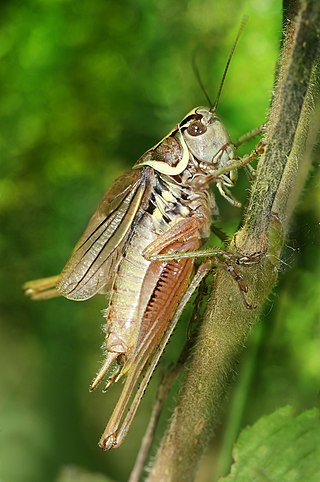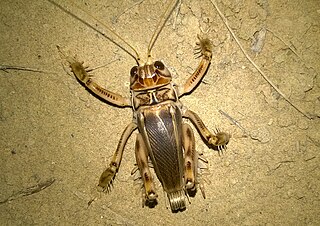
Insects in the family Tettigoniidae are commonly called katydids or bush crickets. They have previously been known as "long-horned grasshoppers". More than 8,000 species are known. Part of the suborder Ensifera, the Tettigoniidae are the only extant (living) family in the superfamily Tettigonioidea.

Mole crickets are members of the insect family Gryllotalpidae, in the order Orthoptera. Mole crickets are cylindrical-bodied, fossorial insects about 3–5 cm (1.2–2.0 in) long as adults, with small eyes and shovel-like fore limbs highly developed for burrowing. They are present in many parts of the world and where they have arrived in new regions, may become agricultural pests.

Gryllinae, or field crickets, are a subfamily of insects in the order Orthoptera and the family Gryllidae.

Roesel's bush-cricket, Roeseliana roeselii is a European bush-cricket, named after August Johann Rösel von Rosenhof, a German entomologist.

The wart-biter is a bush-cricket in the family Tettigoniidae. Its common and scientific names derive from the eighteenth-century Swedish practice of allowing the crickets to nibble at warts to remove them.

The speckled bush-cricket is a flightless species of bush-cricket belonging to the family Tettigoniidae. The species was originally described as Locusta punctatissima in 1792.

The Allpahuayo antbird is a Vulnerable species of bird in subfamily Thamnophilinae of family Thamnophilidae, the "typical antbirds". It is endemic to northeastern Peru.

The black-capped social weaver is a sparrow-like species of bird that has been assigned to the weaverbird family. It was originally described by Fisher and Reichenow, and later re-classified by the latter to the genus Pseudonigrita. Adults have a large black cap, ivory-colored bill, red eyes, brown back and wings, blackish-brown tail, white throat and underparts with a black midline, and dark horn-colored legs. It breeds in colonies and roofed nests with an entrance at the bottom in thorny trees such as acacias are constructed by the male from grass stems. It is found in parts of Ethiopia, Kenya, Somalia, and Tanzania. It is sometimes kept and bred in captivity.

Saga pedo is a species of wingless bush cricket from the southern half of Europe and western and central Asia. This brown or green bush cricket typically has a total length, from the head to the tip of the ovipositor, of up to 10.5 cm (4.1 in), but exceptionally it may reach 12 cm (4.7 in), which makes it one of the largest European insects and one of the world's largest Orthoptera. The head-and-body alone typically is 5–7 cm (2.0–2.8 in) long in adults, but may reach up to 7.8 cm (3.1 in).

Crickets are orthopteran insects which are related to bush crickets, and, more distantly, to grasshoppers. In older literature, such as Imms, "crickets" were placed at the family level, but contemporary authorities including Otte now place them in the superfamily Grylloidea. The word has been used in combination to describe more distantly related taxa in the suborder Ensifera, such as king crickets and mole crickets.

Schizodactylus monstrosus or the maize cricket, is a species of large, robust cricket found in Asia, belonging to the family Schizodactylidae. It is found mainly in sandy habitats along rivers, and has large flattened tarsal extensions and wings that are curled at the tip, right above the cerci. They are nocturnal and show a high degree of variation in activity during the day and night. They hide in burrows that they dig on their own during the day.

Tettigonia cantans is a species of bush crickets belonging to the family Tettigoniidae subfamily Tettigoniinae.

Taeniopoda eques, the western horse lubber grasshopper, is a relatively large grasshopper species of the family Romaleidae found in arid and semi-arid parts of southwestern United States to central and southwestern Mexico. Most populations are identifiable by their shiny black bodies with contrasting yellow markings, but some adults are mostly yellowish, orangish or greenish. The species is unique in using its black coloration to thermoregulate and in being chemically defended. The aposematic coloration warns vertebrate predators of its unpalatability and allows the grasshopper to roost conspicuously upon shrubs.

The Tridactylidae are a family in the insect order Orthoptera. They are small, mole-cricket-like insects, almost always less than 20 mm (0.79 in) long when mature. Generally they are shiny, dark or black, sometimes variegated or sandy-coloured. They commonly live in short tunnels and are commonly known as pygmy mole crickets, though they are not closely related to the true "mole crickets" (Ensifera), as they are included in the Caelifera suborder.

Antaxius pedestris is a species of "bush crickets" belonging to the family Tettigoniidae. It was originally described by Johan Christian Fabricius under the scientific name of Locusta pedestris.

Neoscapteriscus vicinus, commonly known as the tawny mole cricket, is a species of insect in the mole cricket family, Gryllotalpidae. This species is native to South America and also occurs in the Southern United States, where it arrived as a contaminant of ship's ballast around 1900. Colombian insect taxonomist Oscar Cadena-Castañeda studied specimens of the genus which had been called Scapteriscus, and decided that it included two groups; a smaller group and a larger group that he named Neoscapteriscus in 2015. North American mole cricket taxonomists agreed with his decision and altered Orthoptera Species File Online accordingly.
Neoscapteriscus abbreviatus, the short-winged mole cricket, is a species of insect in the mole cricket family, Gryllotalpidae. It is native to South America but has been introduced inadvertently into Florida, in the United States. Unlike other related species, it is unable to fly, nor do the males emit songs in order to attract females.

Anurogryllus arboreus, the common short-tailed cricket or arboreal short-tailed cricket, is a species of cricket in the family Gryllidae. It is native to the southern and south-eastern United States where it lives in a burrow that it digs.

Tachycines asynamorus is a cave cricket and the type species of the genus Tachycines (Rhaphidophoridae). In English-speaking countries it is known as the greenhouse camel cricket or greenhouse stone cricket for its propensity for living in greenhouses. It was first described in 1902 by Russian entomologist Nicolai Adelung on the basis of specimens caught in the palm houses of St. Petersburg. Some authorities have placed this species in the genus Diestrammena, but it has now restored to its basonym.





















